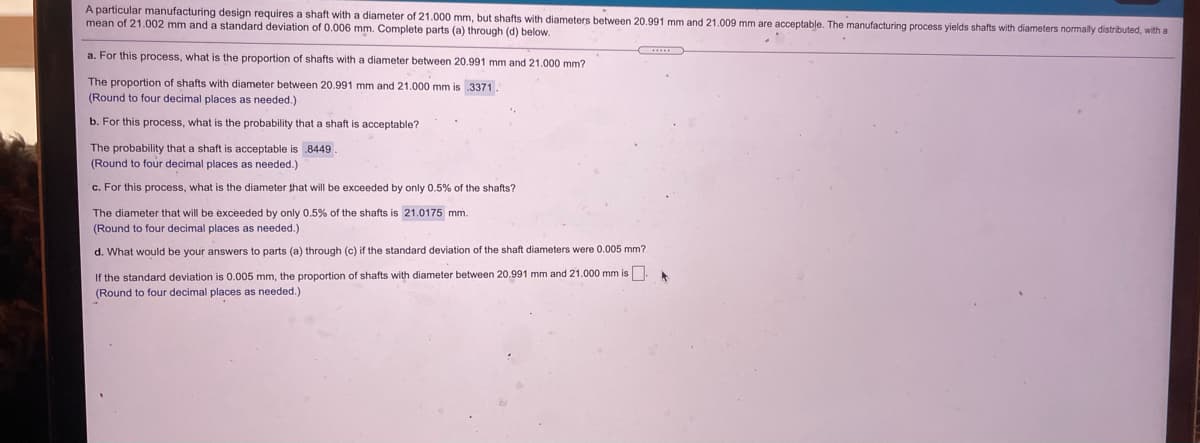d. What would be your answers to parts (a) through (c) if the standard deviation of the shaft diameters were 0.005 mm'
d. What would be your answers to parts (a) through (c) if the standard deviation of the shaft diameters were 0.005 mm'
MATLAB: An Introduction with Applications
6th Edition
ISBN:9781119256830
Author:Amos Gilat
Publisher:Amos Gilat
Chapter1: Starting With Matlab
Section: Chapter Questions
Problem 1P
Related questions
Question
#9
Part 4

Transcribed Image Text:A particular manufacturing design requires a shaft with a diameter of 21.000 mm, but shafts with diameters between 20.991 mm and 21.009 mm are acceptable. The manufacturing process yields shafts with diameters normally distributed, with a
mean of 21.002 mm and a standard deviation of 0.006 mm. Complete parts (a) through (d) below.
a. For this process, what is the proportion of shafts with a diameter between 20.991 mm and 21.000 mm?
The proportion of shafts with diameter between 20.991 mm and 21.000 mm is 3371.
(Round to four decimal places as needed.)
b. For this process, what is the probability that a shaft is acceptable?
The probability that a shaft is acceptable is 8449
(Round to four decimal places as needed.)
c. For this process, what is the diameter that will be exceeded by only 0.5% of the shafts?
The diameter that will be exceeded by only 0.5% of the shafts is 21.0175 mm.
(Round to four decimal places
needed.)
d. What would be your answers to parts (a) through (c) if the standard deviation of the shaft diameters were 0.005 mm?
If the standard deviation is 0.005 mm, the proportion of shafts with diameter between 20.991 mm and 21.000 mm is
(Round to four decimal places as needed.)
Expert Solution
This question has been solved!
Explore an expertly crafted, step-by-step solution for a thorough understanding of key concepts.
This is a popular solution!
Trending now
This is a popular solution!
Step by step
Solved in 2 steps with 1 images

Recommended textbooks for you

MATLAB: An Introduction with Applications
Statistics
ISBN:
9781119256830
Author:
Amos Gilat
Publisher:
John Wiley & Sons Inc

Probability and Statistics for Engineering and th…
Statistics
ISBN:
9781305251809
Author:
Jay L. Devore
Publisher:
Cengage Learning

Statistics for The Behavioral Sciences (MindTap C…
Statistics
ISBN:
9781305504912
Author:
Frederick J Gravetter, Larry B. Wallnau
Publisher:
Cengage Learning

MATLAB: An Introduction with Applications
Statistics
ISBN:
9781119256830
Author:
Amos Gilat
Publisher:
John Wiley & Sons Inc

Probability and Statistics for Engineering and th…
Statistics
ISBN:
9781305251809
Author:
Jay L. Devore
Publisher:
Cengage Learning

Statistics for The Behavioral Sciences (MindTap C…
Statistics
ISBN:
9781305504912
Author:
Frederick J Gravetter, Larry B. Wallnau
Publisher:
Cengage Learning

Elementary Statistics: Picturing the World (7th E…
Statistics
ISBN:
9780134683416
Author:
Ron Larson, Betsy Farber
Publisher:
PEARSON

The Basic Practice of Statistics
Statistics
ISBN:
9781319042578
Author:
David S. Moore, William I. Notz, Michael A. Fligner
Publisher:
W. H. Freeman

Introduction to the Practice of Statistics
Statistics
ISBN:
9781319013387
Author:
David S. Moore, George P. McCabe, Bruce A. Craig
Publisher:
W. H. Freeman